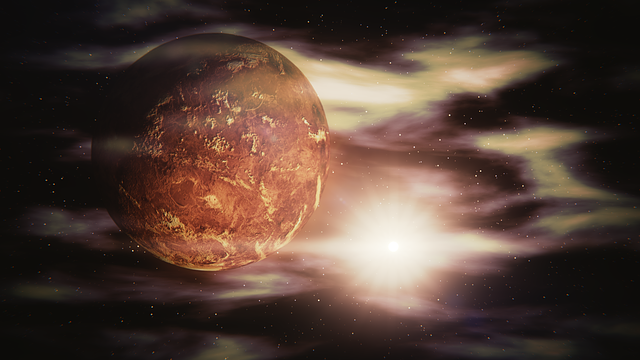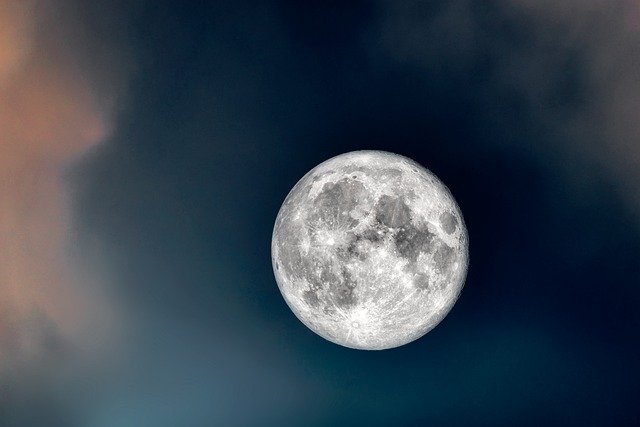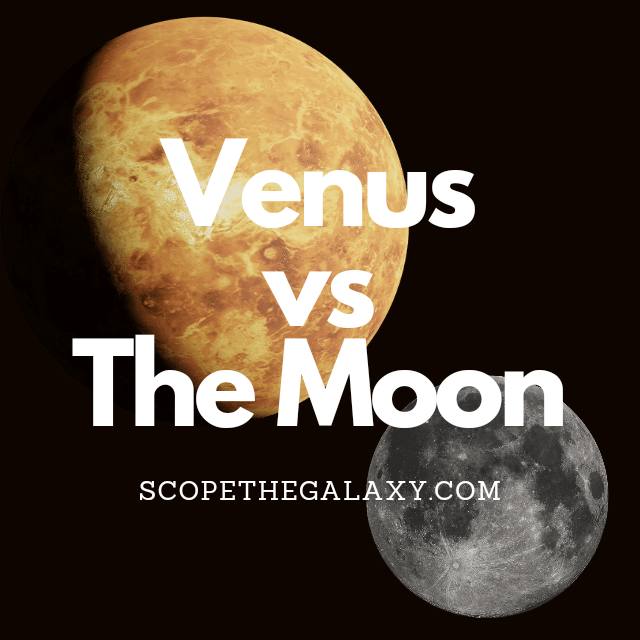*This post may contain affiliate links. This means we may make a commission if you purchase an item using one of our links*
The main differences between Venus and the Moon is that Venus is a terrestrial planet whilst the Moon is a natural satellite that orbits Earth, Venus has a far thicker atmosphere over the Moon’s non-existent atmosphere, Venus is the hottest and brightest planet in our solar system and is roughly 3.5 times the size of the Moon.
There are various other differences between the two so, continue reading if you want a more thorough breakdown of the similarities and differences between them.
What Is The Planet Venus?
Table of Contents

Venus is the 2nd closest planet to the Sun and is often regarded as Earth’s sister planet. It’s very close to our Earth in size where its diameter is 12,104km. This is just over 600km less wide than our home planet.
Unlike all the planets further outside the Sun’s orbit, Venus and even mercury have no moons orbiting it. The most probable reason for this is due to its closer proximity to it, which means that smaller objects orbit the Sun as opposed to Venus.
Venus is also the hottest planet in our solar system where its surface temperature is 475 degrees Celsius. This is due to a number of factors, like the thicker atmosphere, close proximity to Sun, the reasons for which have been explained in more detail here.
It’s core is hot too, similar to that of the ice giants and Earth, where it stands at 5,200 degrees Celsius.
As a result of this thicker atmosphere, Venus is also able to reflect a lot more of the light the Sun projects at it, making it both the hottest and brightness planet in our solar system. This is why for the longest time, and even till this day Venus is often referred to as the morning or evening star.
The thicker atmosphere is mostly compromised of carbon dioxide, and thick clouds of sulfuric acid. This does result sulfuric acid rain on the planets surface, which of course is very corrosive.
Being so close to the Sun also mean its orbital cycle is much shorter. It takes Venus 225 days to complete a full cycle, on the contrary a single day is actually longer than this where it takes around 243 days for a full rotation around its axis.
This is partially down to its distance from the Sun and the thick atmosphere surrounding this terrestrial planet. The axial tilt on Venus is also different from the other planets in our solar system where it is practically straight at 3 degrees.
All in all this is certainly one of the most interesting planets in our solar system and in many peoples eyes, could very well have supported life in the past based on how close its shape and size is to that of Earth.
What Is The Moon?

The moon is the gray celestial being that orbits our Earth. It is also tidally locked to Earth meaning that we only see one side of it at any time in our sky.
It takes the moon roughly 27 days to complete an orbit around Earth, which it does it in an elliptical pattern. The Moon’s axial tilt is very straight at 1.5 degrees. As a resut of the tidally locked status along with the effects that Earth has on Its general rotational patterns, it takes the Moon roughly 29.5 days to complete a day.
In regards to its temperature, it fluctuates where it can be really hot at 127 degrees Celsius when the Sun is shining on it and to -173 degrees in areas where the Sun does not strike it. It’s core on the other hand is far hotter ranging between 1,327 to 1,427 degrees Celsius.
This is as a result of the lunar entity’s extremely thin to practically non-existent atmosphere, which not only results in these massive temeprature shifts bu,t is also the reason why it has over 100,000 craters on its surface.
Speaking of the Moon’s surface, the entity is mostly made of rocks, iron, magnesium just like most of the other moons and terrestrial based planets in our solar system.
It is among the bigger moons in our solar system with a diameter of 3,474.8km and a mass of 7.35 × 10^22 kg, which actually places it fifth amongst all moons in our solar system and would also make it bigger than the dwarf planet pluto.
Despite all the advancements in technology, the last time a manned mission was made to the Moon was on the Apollo 17 way back in Decemeber 1972 and no further missons have been done since, possibly as result of the polictial agendas behind the numerous countries vying for oppurtunties that we don’t know of.
How Are Venus And The Moon Similar?
Venus and the Moon do share few a common features, which would include the below:
- Both have a hotter central core.
- Both are a spherical in shape.
- Both have a rocky surface.
- Both have no rings surrounding them.
- Neither have any other moon like objects orbiting it.
- Both have an axial tilt belwo 5 degrees
Differences Between Venus And The Moon
As for the differences between these two, they include the following:
- The Moon is a natural satellite that orbits another planet whilst Venus is a terrestrial planet.
- Venus is the brightest celestial object (besides the Sun) in our solar system.
- Venus orbits the Moon in a circular pattern whilst the Moon orbits Earth in an elliptical pattern.
- In regards to their orbital periods it takes Venus 225 days to orbit the Sun whilst the Moon orbits Earth in 27 days or orbits the Sun along with Earth in roughly 365 days.
- Venus is the hottest planet in or solar system where it averages 475 degrees Celsius whilst the Moon fluctuates between 127 degrees Celsius and -173 degrees Celsius depending on which side the Sun is shining on.
- The Moon has a practically non-existent atmosphere/exosphere whilst Venus has thickest atmosphere amongst the terrestrial planets.
- Venus has more mass where it stands at 4.867 × 10^24 kg as opposed to Moon’s that is 7.35 × 10^22 kg.
- A day on Venus is longer than its orbital cycle where it stands at 243 days and a day on the Moon is also longer hitting 29.5 days.
- Venus has an axial tilt of 3 degrees compared to the Moon’s 1.5 degrees.
- Venus’ core is hotter than the Moon’s at 5,200 degrees Celsius whereas the Moon’s core temperature ranges between 1,327 degress Celsius and 1,427 degress Celsius.
Summary
Venus is the hottest, brightest and second biggest terrestrial planet in our solar system whilst the Moon is simply the 5th biggest natural satellite in our solar system, with an extremely thin exosphere and a ton of craters on its surface.
Although the Moon and Venus do share many features such as their general terrestrial composition, their shape, no other large natural satellites orbiting them and so on but, in a general sense they function very differently from one another which is why they’re universally categoriesed by astronomers under different brackets

